|
A NEW FOSSIL SPECIES OF THE GENUS HONGKONGITES
FROM TOLO CHANNEL FORMATION:
TAXONOMICAL REVIEWS OF H. hongkongensis &
H. liberalis sp. nov.
We would like to dedicate to the pioneers who
have contributed to the study of Hongkonites,
also pay tribute to Hong Kong people in misery.
Owen et E. Ng
Cognitio Sapiens Ngensis, Acta Scientrium Ngensis,
Email address: hongkongites@gmail.com
 CHINESE VERSION
CHINESE VERSION
 MAIN
MAIN
 AETAS GEOLOGICA HONGKONGICA (Chinese)
AETAS GEOLOGICA HONGKONGICA (Chinese)
ABSTRACT
New
finds of Hongkongites fossils helps to solve of taxonomical
problems and restore the status of genus Hongkonites, a detailed
information of Hongkongites hongkongensis Grabau, 1923 is
included and the conceived reconstruction of their suture lines, and
also describes a new species Hongkongites liberalis Ng et al.,
2020.
KEY WORDS
Hongkongites hongkongensis Grabau, 1923,
Genus Hongkongites, Family: Schlotheimiidae, Tolo Channel
Foramtion (Nai Chung area, Fung Wong Wat area, seashore area of Pak Kok
Chai, Northern New Terrorities, Hong Kong), Early Jurassic (196.5~189.6
Ma) .
STRATIGRAPHY OF THE LOCALITIES
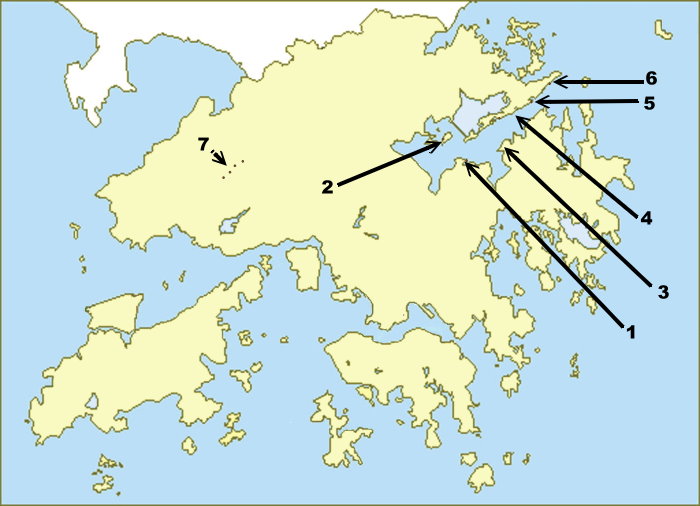
Map of
geographic range: Tolo Channel Formation

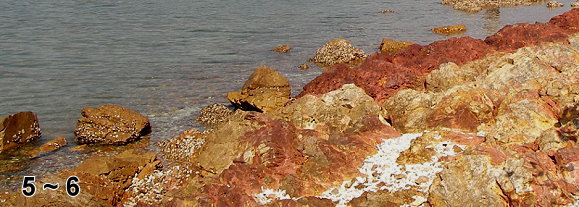
Landforms of Tolo Channel
Formation (1.
Nai Chung, 2.Ma
Shi Chau,
3.Sham
Chung,
4.Sea
Shore of Tolo Channel,
5.Fung
Wong Wat,
6.Seashore
of Pak Kok Chai),
7.
Tai Tong, Yuen Long (Not investigated)
The Tolo
Channel Foramtion of early Jurassic age (196.5Ma ~ 189.6Ma)[1] consists
of of grey laminated siltstone with interbedded fossiliferous black
mudstone, it is confined to narrow exposures on Nai Chung, Ma
Shi Chau. Sam Chung, Fung Wong Wat area and seashore
area of Pak Kok Chai on the both side of Tolo Channel, in
Northern New Terrorities, Hong Kong. Since a pebbled-liked
Hongkongites fossil (HKF-001) was collected from the tidal area at
the seashore area of Nai Chung in 2009, no more specimens has
been found again. Some human activities that cause damage to the rock on
this site and becoming a public place of kitting & clam collecting.
Otherwise, Some single, pair of specimens or small groups of poor
preservation Hongkongites remains can be found in Fung Wong
Wat area & seashore area of Pak Kok Chai sites of Tolo
Channel Formation, and which is faulted at the rock base against the
Devonian Bluff Head Formation (The most ancient formation in Hong
Kong,), Hongkongites has not been recorded in Ma Shi Chau
& Sham Chung.
REVIEWS OF THE STATUS OF GENUS HONGKONGITES

Hongkongites
specimen
shows that each coarse ribbing on both sides stops growing on the center
of the abdomen to form a band with the same height as the shell surface (plain groove)
Pg, HKF-001A and cast model
in right, bar length = 5mm,
Hongkongites
and other relatives have combined to from a new genus
Sulciferites
by Arkell in 1975, and based on the specimens examined has coarse
ribbing that is furcate near the umbilical shoulder and interrupted by
VENTRAL groove [8], after that Hongkongites is widely described to be a
synonym of Sulciferites (Donovan & Forsey, 1973), this classified
standard had also been applied this genus with the new ‘Sulciferites
hongkongensis Y. G. Wang et P. L. Smith, 1986 ‘ to
related paper which was published in 1986.
No one has
ever raised doubts for this taxonomical arrangement until 2020, after
quite a lot of specimens has been collected and examined for a terms of
more 10 years, we found that the has coarse ribbing that is furcate near
the umbilical shoulder and teminated by PLAIN groove (Pg, HKF-001A,HKF-001C, HKF-020A),
it indicated the genus Hongkongites is quite different from those
characters of ‘Sulciferites’.
On the other
side, two types of coarse ribbing can be observed from all specimens
from the both origins (HK & GD), it may simply be divided as ‘straight
ribbing (simple), I” and “forked ribbing (bifurcate), Y”, we noted that
HK specimens demonstrates the irregular and random configuration of “I”
& “Y” from their coarse rubbing between the whorl on the shell, and
presents the IIIYIYIIYIYYI pattern, but 14 specimens from Huizhai, Jiexi
County, Guangdong Province, China, which were identified as ‘Sulciferites
hongkongensis Y. G. Wang et P. L. Smith, 1986‘
demonstrates the regular configuration of IYYYIYYYIYY pattern.
The genus
Hongkongites should be restored and for all ‘Sulciferites’
specimens from Hong Kong.
After the
fossils are hardened by Fe-rich minerals and weathered, sea eroded then
mechanically rubbed, unclear relationships status between
Hongkongites & its relatives may be caused by the most of specimens
from the rock outcrops were in a poor state of preservation.
Fortunately, an enigmatic NGF-001X specimen is found inside the rock
materials when the Hongkongites rich stones were investigated.
accompanying juvenile individuals with their partial well-preserved
parents remains are completely preserved by the loose mudstone, the
coarse ribbings of the adult ammonites are sharp, and they still have a
bone-liked structure, which is obviously different from the matrix
mudstone. HKF-020 provides very helpful evidences for the
interpretation.
We are also
examined the “smaller” specimens were found accompanying the “typical”
Hongkongites, compact coarse ribbing on the shell with the
IIIYIYIIYIYYI pattern, the specimen is also a specimen of
Hongkongites and similar to the Hongkongites angulatoides (Quenstedt),
Williams, 1943 (nomen nudum,
no more information
for further reference), we ever formally combined both to the same
species, and smaller individuals as juvenile ammonite (Ng et al, 2009).
After investigating for these specimens, a new species is described
based on its unique morphic characters.
CLASSIFICATION & MORPHOLOGY
 Phylum:
Mollusca Phylum:
Mollusca
 Class:
Cephalopoda Class:
Cephalopoda
 Subclass:
Ammonoidea(Extinct) Subclass:
Ammonoidea(Extinct)
 Order:
Ammonitida Order:
Ammonitida
 Suborder:
Ammonitina Suborder:
Ammonitina
 Superfamily:
Psilocerataceae Superfamily:
Psilocerataceae
 Family:
Schlotheimiidae Family:
Schlotheimiidae
 Genus:
Hongkongites Genus:
Hongkongites
Era:
Sinemurian (Early Jurassic strata, it spans the time between 196.5 Ma to
189.6 Ma)
Locality: Tolo Channel Foramtion, mainly Northern New Terrorities,
Hong Kong. at Nai Chung & Sham Chum Area, in contrast to
the strata of the adjoining crop of granite that cause damage to the
fossil on this site by high temperature during the geological movement.
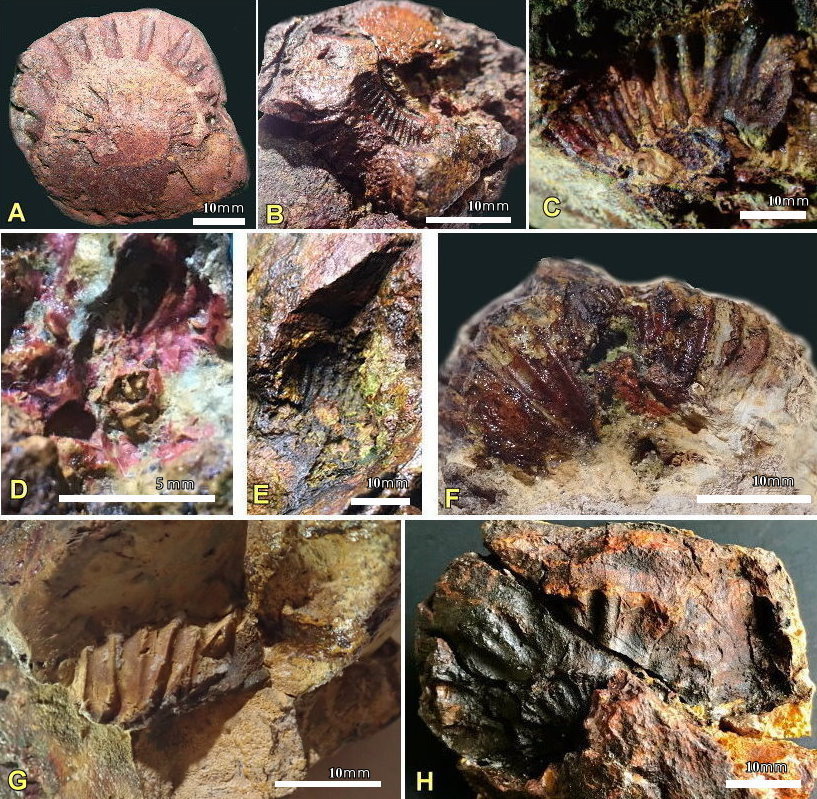
Hongkongites
hongkongensis (Grabau), 1923: A. HKF-001,
Nai Chung, 2009, B. HKF-001A, C. HKF-001B, inner wall,
D. HKF-001B (Juvenile), E. HKF-001C, F.HKF-001E
G.
HKF-001F, shell fragment, H. HKF-001Z
1.
香港菊石 Hongkongites
hongkongensis (Grabau), 1923 ( = Hoplites
hongkongensis Grabau, 1920), A Lower
Cretaceous ammonite from Hong Kong, South China. Bull. Geol. Surv.
China 5: P.199–208.
Voucher
Specimens: HKF-001, HKF-001A, HKF-001B, HKF-001C, HKF-001D, HKF-001E,
HKF-001F, HKF-001Z
Description: Shell diameter ca.20mm [ref. HKF-001=20mm, collected
from Nai Chung in 2009, poor preservation, pebbled-liked fossil,
no outer coiled shell, (HKF-001B,E) = 13mm, HKF-001Z=29mm], reddish to
dark brown color, ventral narrowly round to oval, mid-evolute whorl with
3 coiled shell, slightly convex to flank flat, ribs sharp, simple and
bifurcate,
demonstrates the irregular configuration of IIIYIYIIYIYYI pattern.
primitive coil contains 8~10 ribs, secondary coil contains 15~18 ribs
and outer coil contains 20~25 ribs, 0.8~1.2mm in width, distance between
ribs: 0.95~18mm (adult, outer ribs), coarse ribbing that is furcate near
the umbilical shoulder and interrupted by plain groove. Ribbing on inner
side of the shell (septum) strength varying considerably,
simple and bifurcate,
0.9mm width, distance 1.0~1.9mm (ref. HKF-001B).
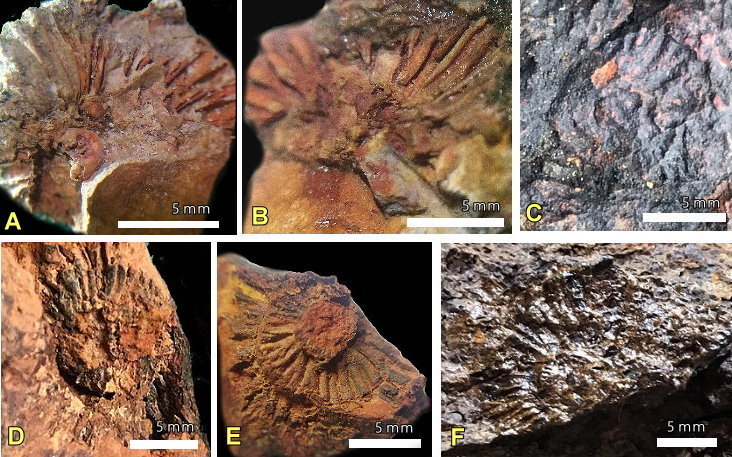
Hongkongites liberalis
Ng et al., 2020,
sp. nov, Adult.: A. HKF-020,
slab, B. HKF-020,countslab, C. HKF-020F, impression,
D. HKF-020A, slab, E. HKF-020A, counterslab, F. HKF-020B

Hongkongites liberalis
Ng et al., 2020,
sp. nov., Juvenile: A. HKF-020K,
slab, B. HKF-020, C. HKF-020, new-born, individual
2.
光復香港菊石
Hongkongites liberalis
Ng et al., 2020,
sp. nov., Etymology: this tiny species is named after the Roman goddess
Libertas and refer to the compact radial pattern on the shell,
such as sun rays, is a metaphor for bright freedom, we hereby record
Hong Kong's glory in tribulation and the best wish for the future.
Typrus:
HKF-020, Isotyprus: HKF-020A, HKF-020B, HKF-020C,
HKF-020D, HKF-020F, HKF-020E, HKF-020H, HKF-020I, HKF-020J,HKF-020K
Locality &
yerars of collecting: Tolo Channel Formation, 2009~2020.
Fossil
condition: impression and poor-preservation specimen form outcrop,
well-preservation specimens from inside of the mudstone.
Description:
Adult, a tiny and compact ammonid ,
coarse rubbings are more
denser than Hongkongites hongkongensis (Grabau),
1923, Shell diameter ca.15mm
[(HKF-020B)=15mm、(HKF-020A)=15mm],
, primitive coil contains 8~12 ribs, secondary coil contains 19~25 ribs
and outer coil contains 30~35 ribs, sometimes it may confuse with the
juvenile individuals of H. hongkongensis because they
shared the same strata.
Unlike those of H. hongkongensis, only impression or mold
are collected, no cast can be observed in outcrop, all cast specimens of
the new species are collected from the inside part of the fossil base
accidentally.
Juvenile
(HKF020, HKF-020A, HKF-020K):
when the enigmatic HKF-020 specimen is examined under high power
microscopy, we note that a special ‘Ombilic’ is a single individual, it
is not fragments of umbilicus from the adult, it may be new born
ammonid, which is clearly show
that it is the specimen of existence of the parents & juvenile and this
may be the first time it was discovered.
SUTURE LINES
1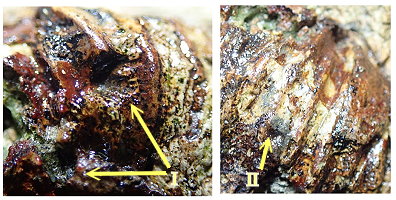 2 2
 3 3.jpg)
4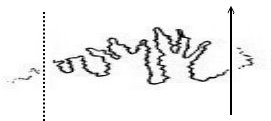 5 5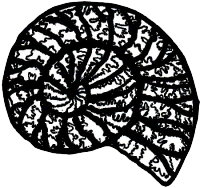
Fig;1. HKF-001E
H.hongkonensis, 2. HKF-020 H.liberalis (Adult),
3.HKF-020 H.liberalis (juvenile), 4.. scuture line,
5. Conceived reconstruction of
suture pattern
The order and suborder of
Ammonite are also the basis for identifying the age of life. The
existing ammonite sutures are divided into four categories, representing
species of different ages. Due
to the poor preservation of Hongkongites, it is impossible to
obtain directly from the specimens. Most of
fossils have a rough shell surface, and
most of them are attached to mudstone with a very thin brittle fossil
layer, which is never feasible by sanding treatment. HKF-001E is a
half-buried in the mud of adult Hongkongites, the keeping quality
significantly better than the other specimens.
Studying on the natural peeling of the
outer surface of the shell part ( I ) leaves a light-colored impression
or the outer edge of the hole (II) has a regular ventral saddle
and ventral lobe, HKF-020 is an uncompleted specimen that the shape of
the suture near the umbilicus (III) could also be described.
Suture patterns of
Hongkongites belongs to Ammonitic suture, it can be traced back to
the Permian to Cretaceous.
NOTES
A
considerable amount of Hongkongites still exists in their sites
of locality, and it is still possible to be found more perfect specimens
in future. We don’t want any more foreign organizations to exhaust Hong
Kong ’s fossils and take them away from Hong Kong. It should be
understood that the importance of protection of both of fossils and
geological sites, At the same time, defending our dignity, and our core
values and especially for our young generation in Hong Kong is more
important! This research project for this paper does not require any
funding. We are very grateful for the beautiful and lovely Nature of
Hong Kong.
REFERENCE:
[1] fossilworks, Gateway to the Paleobiology Database, http://fossilworks.org/
[2]《香港地質考察指引》香港土木拓展署, 2007/06
[3] R.J.Swell et al., The Pre-Quarternary Grologgy of Hong Kong,
GEO,GEDD, 2000/08.
[4] 蘇偉賢(Roderick J Sewell)等《香港地質-四億年的旅程 = Hong Kong Geology- A
400-million year journey》, HKGS, CEDD, 2009/09.
[5] 駱永明 等《香港地區土壞及其環境》, 科學出版社, 2007/09.
[6] 歐達敦著、李作明譯《香港岩石》, 市政局出版, 1988
[7] 何國雄、李作明《香港古生物和地層:香港鳳凰笏和深涌等地早侏羅世菊石 》P.104-120, 科學出版社, 1997.
[8] Sinemurian (Early Jurassic) ammonite fauna from the Guangdong
region of southern China, Sinemurian (Early Jurassic) ammonite fauna
from the Guangdong region of southern China, Sept., 1986. Journal of
Paleontology 60(05):1075-1085.
|